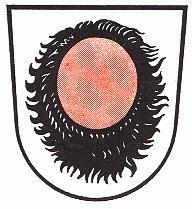Pfaffenhofen: Difference between revisions
Jump to navigation
Jump to search
Knorrepoes (talk | contribs) No edit summary |
Knorrepoes (talk | contribs) |
||
| Line 16: | Line 16: | ||
====Origin/meaning==== | ====Origin/meaning==== | ||
The | The arms were granted in 1956. | ||
The oldest seal of the villages dates from between 1463 and 1482 and show a human figure standing behind a wooden fence. This may have been a canting image; a monk (Pfaffen) in a garden (Hof). In any case, from 1583 onwards as arms and from 1684 also on seals, the shaven (monk's) head appears as the symbol of the village. It was based on these old images that the arms were granted in 1956. | |||
[[Literature]] : Stadler, K. : Deutsche Wappen - Bundesrepublik Deutschland. Angelsachsen Verlag, 1964-1971, 8 volumes. | [[Literature]] : Stadler, K. : Deutsche Wappen - Bundesrepublik Deutschland. Angelsachsen Verlag, 1964-1971, 8 volumes. | ||
Revision as of 10:30, 27 April 2014
| Heraldry of the World Civic heraldry of Germany - Deutsche Wappen (Gemeindewappen/Kreiswappen) |
PFAFFENHOFEN
District (Kreis) : Heilbronn State : Baden-Württemberg
Official blazon
In Silber eine fleischfarbene Priestertonsur mit schwarzem Haarkranz.
Origin/meaning
The arms were granted in 1956.
The oldest seal of the villages dates from between 1463 and 1482 and show a human figure standing behind a wooden fence. This may have been a canting image; a monk (Pfaffen) in a garden (Hof). In any case, from 1583 onwards as arms and from 1684 also on seals, the shaven (monk's) head appears as the symbol of the village. It was based on these old images that the arms were granted in 1956.
Literature : Stadler, K. : Deutsche Wappen - Bundesrepublik Deutschland. Angelsachsen Verlag, 1964-1971, 8 volumes.

